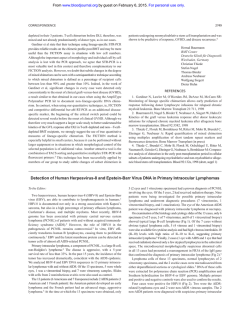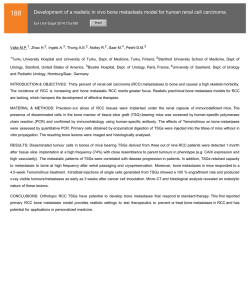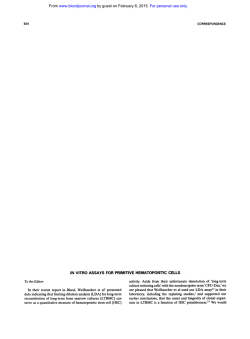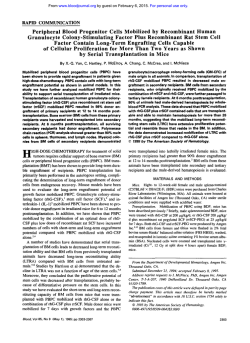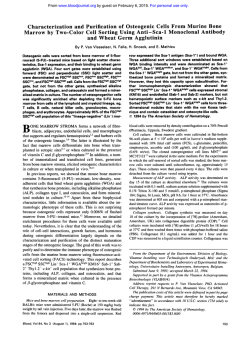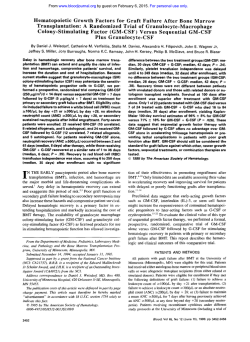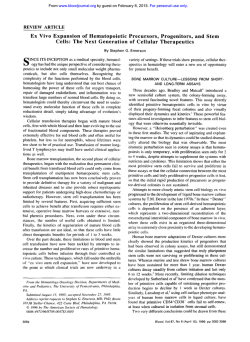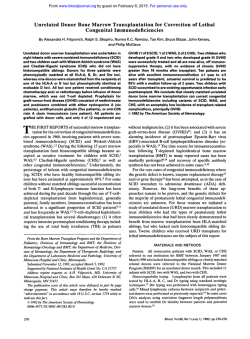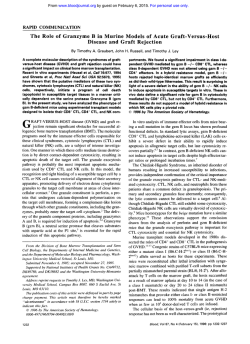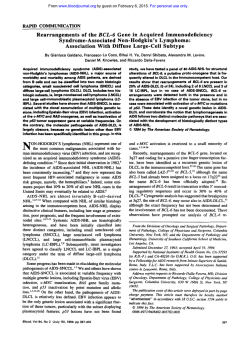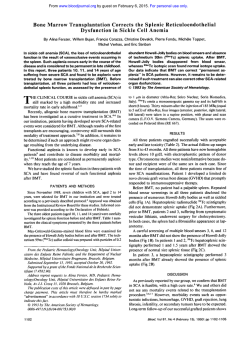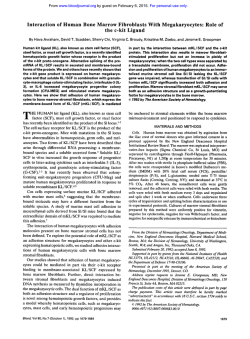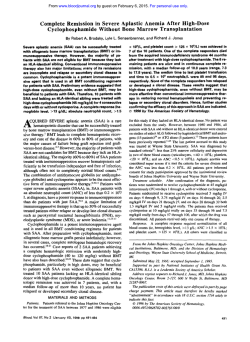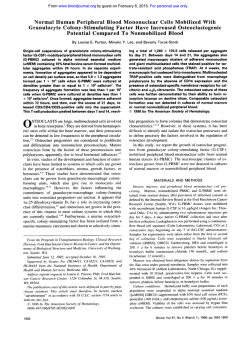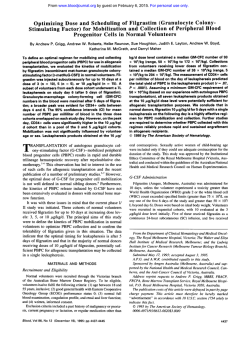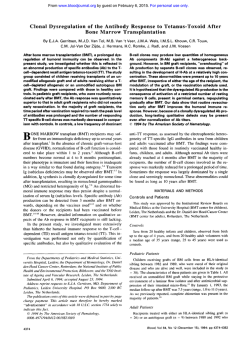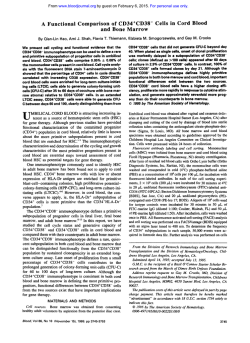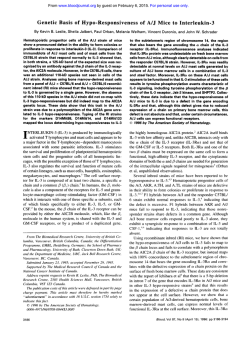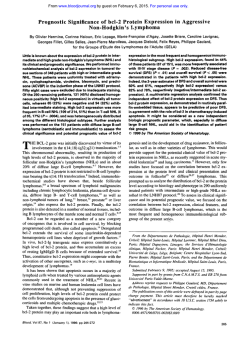
Intensive Therapy With Peripheral Blood Progenitor Cell
From www.bloodjournal.org by guest on February 6, 2015. For personal use only. Intensive Therapy With Peripheral Blood Progenitor Cell Transplantation in 60 Patients With Poor-Prognosis Follicular Lymphoma By Y. Bastion, P. Brice, C. Haioun, A. Sonet, G. Salles, J.P. Marolleau, and B. Coiffier D. Espinouse, F. Reyes, C. Gisselbrecht, Intensivetherapy, mainly with purged autologous bone marrow transplantation (ABMT), has been proposed in recent years as consolidation treatment in young patients with follicular lymphoma. Reported experience with transplantation of peripheral blood progenitor cells (PBPC) is,so far, limited. The feasibilii and the therapeutic efficacy of intensive therapy followed by unpurged autologous PBPC reinfusion were evaluated in 60 patients with poor-prognosis follicular lymphoma. Twelve patients were in first partial remission (PR), 34 were in second partial or complete remission (CR), and 14 were in subsequent progression.At the timeof the procedure, 39 patients (65%) had persistent bone marrow involvement, 49 patients (82%) were in PR, and 16 patients had presented with a histologic transformation (HT). PBPC were collected after chemotherapy followed by granulocyte (G) colony-stimulating factor (CSF) or granulocyte-rnacrophage (GM)-CSF in 50 patients. Conditioning regimens included high-dose chemotherapy alone (14 patients); mainly regithe BCNU, etoposide,aracytine,melphalan[BEAM] men), or cyclophosphamide with or without etoposide plus total body irradiation (46 patients).The median time t o reach a neutrophil count greater than 0.5 x 109/L was 13days. There were five treatment-related deaths, with four being associated with a delayed engraftment and all occurring in patients in third or subsequent progression. At a median follow-up of 21 months, 48 patients were still alive, 18 relapsed, and sevendied of lymphoma progression. Estimated %year overall survival (OS) and failure-free survival (FFS) rates were 86% and 53%, respectively, without a plateau. Patients treated in PR1 or PR2/CR2 had asignificantly longer rate of OS and FFS than those treated in subsequent progression (P= .002 and P = .001, respectively), whereasage, response to salvage treatment, presence or absence of residual bone marrow involvement, orconditioning regimen had no influence on outcome. Patients with HT tended t o have a worse FFS rate ( P = .04) without an OS difference. Along with an unusual rate of engrafment failure, the poor FFS observed in heavily pretreated patients suggests that intensive therapy should be performed early in the course of the disease. Given the highpercentage ofpatients intensified in PR with residual bonemarrow involvement, our results are comparable with those achieved with ABMT published t o date. Prospectivetrials are warranted t o compare this strategy with standard therapy in patients with relapsing or PR follicular lymphoma. 0 1995 by The American Society of Hematology. A have theoretical advantages compared with bone marrow cells. First, hematologic recovery is more rapid with PBPC than with bone marrow cells.I4Second, peripheral blood may be less contaminated by tumor cells, although this has not been proven.” Third, this strategy remains feasible in heavily pretreated patients, especially in those who have received previous pelvic radiotherapy.“j The reported experience with high-dose therapy followed by PBPC reinfusion is, so far, very limited in patients with follicular 1ymph0ma.l~~~~ We present here the results obtained in 60 patients with follicular lymphoma treated with high-dose therapy and PBPC support in three French centers. The vast majority of these patients were in the second or a subsequent phase of their disease and had persistent bone marrow involvement at the time of the procedure. LTHOUGH FOLLICULAR lymphomas are characterized by a relatively indolent course, they remain an incurable disease in spite of various therapeutic approaches. Median survival ranges from 6 to 10 years in recent studi e ~ with ” ~ a constant annual rate of relapse and death. In recent years, prognostic factors have been better defined,’ and the notion that a complete clinical remission is associated with a longer outcome has e~nerged.~.~ Recently, the use of intensive therapy supported by autologous bone marrow transplantation (ABMT) has been investigated in these patients, especially for those aged less than 60 years with recurrent d i ~ e a s e . ~In” the ~ experience of St Bartholomew’s Hospital (London, UK), this strategy seems to be able to prolong remission duration.’ However, this longer time-to-progression survival and the possible impact on overall survival have not been proven in randomized controlled trials. Furthermore, the optimal modalities of this therapeutic approach and, particularly, the influence of in vitro treatment of the bone marrow on disease recurrence remain unknown. In the experience of the Dana-Farber Cancer Institute (Boston, MA), antibody-mediated purging eliminated lymphoma cells detectable by polymerase chain reaction (PCR) in hematopoietic stem cell harvests in about half of the patients who had a breakpoint involving the bcl-2 translocation, and disappearance of bcl-2-rearranged cells after in vitro treatment was the single most important prognostic factor for freedom from recurrence.” On the other hand, disappearance of bcl2-rearranged cells has rarely been achieved in the experience of the St Bartholomew’s Hospital, and the impact of successful purging on further outcome is not clear.” Furthermore, the overall survival rates from the two centers are the same.I3 The use of peripheral blood progenitor cells (PBPC) may Blood, Vol 86, No 8 (October 15). 1995:pp 3257-3262 Fromthe Service d’Himatologie, Centre Hospitalier Lyon-Sud, Pierre-Bdnite; the Service d’Himatologie, Hbpital Saint-Louis, Paris; and the Service d’Himatologie, Hbpital Henri Mondor, Criteil, France. Submitted February 2, 1995; accepted June 22, 1995. Supported in part by the Ligue Contre le Cancer du Rhone et de la Saone et Loire and by the Projet Hospitalier de Recherche Clinique (HCL PHRC-004). Address reprint request to Y. Bastion, MD, Service d’Himatologie, Centre Hospitalier Lyon-Sud, 69495 Pierre-Bdnite Cedex, France. The publication costs of this article were defrayed in part by page charge payment. This article must therefore be hereby marked “advertisement” in accordance with 18 U.S.C. section 1734 solely to indicate this fact. 0 1995 by The American Society of Hematology. 0006-4971/95/8608-06$3.00/0 3257 From www.bloodjournal.org by guest on February 6, 2015. For personal use only. 3258 BASTION ET AL PATIENTS AND METHODS Sixty patients, aged 20 to 58 years (median age, 47 years), treated between August 1990 and April 1994 in Lyon-Sud (34 patients), Paris-St-Louis (18 patients), and Crkteil (eight patients), France, form the basis of this analysis. The clinical characteristics of these patients are listed in Table 1. Patients were considered to have a large tumor burden if they had at least one of the following criteria, as determined by an analysis of the literature and a previous study”: any nodal or extranodal tumor mass with a diameter larger than 7 cm; involvement of at least three nodal sites, each of which had a diameter larger than 3 cm; systemic symptoms; substantial splenic enlargement; serous effusion; orbital or epidural involvement or ureteral compression; andor leukemic presentation. In a previous study, patients with such characteristics at diagnosis and treated with a CHOP (cyclophosphamide, adziblastine, vinezistine, and prednisone)-like chemotherapy regimen with or without interferon experienced a median event-free survival of 28 months and an estimated median overall survival of about 60 months.’” Twelve patients were in first partial remission. In all cases but one, intensive therapy was used because of the presence of at least one of the following parameters: presence at diagnosis of a composite histology with coexistence of a more aggressive diffuse lymphoma (three patients), presence of at least one adverse prognostic factor as defined above (10 patients), failure of a CHOP-like chemotherapy regimen used as first-line treatment (1 1 patients). Thirty-four patients were in second partial or complete remission. Patients. Table 1. Characteristics of the 60 Patients With Follicular Lymphoma Treated With Intensive Therapy and PBPC Support Characteristic All Patients No. Median age (yr) Initial subtype Small cell Mixed 2 Large cell HT Initial stage I II 111 1V Bone marrow involvement 22 High tumor burden at diagnosis* Median no. of previous regimens Anthracyclin-containing 33 regimen Previous CR Status at time of intensive therapy CR PR Stable disease Median mos from diagnosis to intensive therapy Residual bone marrow involvement at time of intensive therapy N Y 11 Residual tumor mass at time of intensive therapy N <2 cm 2 2 cm + 60 41 Patients in PR1 14 Patients in CR2/PR2 Patients in r 3 r d Phase 12 46 34 44 21 32 7 16 1 8 3 3 14 5 - 3 8 23 2 1 11 9 23 5 9 46 42 38 12 11 10 2 1 58 25 11 10 2 49 18 6 6 2 3 3.5 14 9 - 16 - 8 25 1 2 12 10 49 1 12 33.5 11.5 33.5 63.5 21 39 1 14 20 6 8 24 13 23 4 5 3 14 12 8 6 6 2 Criteria of the GELF-86 protocol?’ - - Adverse prognostic factors as defined above were present at diagnosis in 23 of them (68%). Ten patients had presented with a histologic transformation (HT) as second progression of their disease. Fourteen patients were in subsequent progression. Initial treatment was chlorambucil or prednimustine in seven patients (12%), CHVP regimen (cyclophosphamide 600 mg/m’, doxorubicin 25 mg/m2, teniposide 60 mg/m2, prednisone 40 mg/mz/d x 5 days) with (1 1 patients) or without (six patients) interferon-a2;’ in 17 patients (28%), standard-dose or high-dose CHOP’’in23 patients (38%), multidrug regimens without anthracyclin in six patients (IO%), fludarabine monophosphate in four patients (7%), interferon-azbin two patients (3%), and radiotherapy in one patient (2%). At the time of intensive therapy, all patients except two hadreceived at least one anthracyclin-containing regimen. Seven patients had received localized radiotherapy. Sixteen patients (27%)had experienced HT in the course of their disease. Forty-nine patients (82%) had a history of previous bone marrow involvement, and 38 patients had persistent marrow involvement at the time of stem cell harvest (63%). Twenty-five patients (42%) had reacheda complete remission in the course of their disease before intensive therapy. Pretransplunt status. All patients except one responded to salvage treatment, but only 10 patients were in complete remission (CR). Forty-nine patients were in partial remission (PR), 37 with a minimal disease defined as reduction of the tumor masses to 2 cm or Fourteen of themhad residual bonemarrow involvement as the only site of residual disease. PBPC collection. At the time of PBPC collection, none of the patients had cytologic evidence of blood involvement by lymphoma cells. In those patients with previous blood involvement, immunologic studies were performed to search for a monoclonal B-cell fraction andwere negative. Peripheral mononuclear cells (MNC) were collected after a cycle of cytotoxic chemotherapy followed in 50 cases by granulocyte (G) colony-stimulating factor (CSF; 28 patients) or granulocyte-macrophage (GM)-CSF (22 patients). The chemotherapy regimen used for PBPC mobilization was high-dose cyclophosphamide in 30 patients, a CHOP or CHOP-like regimen in 15 patients, high-dose cyclophosphamide plus etoposide in eight patients, and another cytotoxic regimen in seven patients (with mitoxantrone in five patients; without anthracyclin or mitoxantrone in two patients). The collections were performed daily to obtain at least 2 X lo8 MNC per kilogram in 1990 and 1991 and at least 4 X IOR MNC per kilogram in the following period, with at least 2 X lo4 colony-forming units/granulocyte-macrophage (CFU-GM) per kdogram in both cases in Lyon-Sud, France. The minimum requirements for CFU-GM were, respectively, 2 X lo4 and 4 X IO4 CFL-GM per kilogram in Pari-St-Louis and Creteil, France. A median MNC number of 4.25 X 10*/kg(range, 0.85 X IO8 to 16 x 10’) and a median CFU-GM number of 9.95 X 104/kg were collected after a median number of 3.5 aphereses (range, one to nine). The MNC were then cryopreserved without any in vitro manipulation in the patient’s serum with 10% dimethyl sulfoxide (DMSO) in the vaporphase of liquid nitrogen. In two patients (LyonSud), the number of MNC and CFU-GM collected were below the planned thresholds; considering the poor prognosis of their disease (both patients had experienced HT, andonehad been previously treated with ABMT), intensification was performed. Conditioning regimen. Conditioning regimens are shown in Table 2. Forty-six patients received cyclophosphamide plus etoposide (43 patients) and total body irradiation (TBI) as conditioning regimen. Because of extensive previous therapy, one patient inthird progression of his disease received TB1 as a single dose of 8 Gy; in other patients, TB1 was administered at a dose of 10 or 12 Gy, whether fractionated or unfractionated according to each center’s policy. However, because of previous radiotherapy or extensive pre- From www.bloodjournal.org by guest on February 6, 2015. For personal use only. 3259 INTENSIVETHERAPY WITH PBPCT IN FCL PATIENTS vious chemotherapy, 14 patients received a pretransplant regimen consisting of high-dose chemotherapy only. Median time from PBPC collection to intensive therapy was 43 days (range, 9 to 376 days). Thirty-three patients received no further treatment between PBPC collection and high-dose therapy, and 27 patients received at least one course of chemotherapy (median, one; range, one to six) during this interval. Fifty-two patients received a hematopoietic growth factor after PBPC reinfusion (GM-CSF, 30 patients; G-CSF, 22 patients) until neutrophil recovery. Response criteria. Engraftment failure was defined as the absence of persistant recovery of neutrophil count greater than 0.500 x 1 0 9 L CR was defined as the disappearance of all sites of disease including bone marrow. PR was defined as a reduction of more than 50% in the largest diameter of each measurable site of disease, or as the persistence of bone marrow infiltration as the only residual site of disease. Otherwise, the patient was considered as nonresponding. Response was assessed 3 months after high-dose therapy with clinical examination, computed tomography (CT) scan, bone marrow aspirate, and biopsy. Statistical methods. Overall survival (OS) was defined as the time from reinfusion of PBPC to death or date of last visit. Failurefree survival (FFS) was defined as the time from reinfusion of PBPC to the time of disease progression, last follow-up, or death from any cause. Survival distributions were estimated using the product-limit method of Ka~lan-Meier.'~ Thestatistical significance of observed differences in the distributions of OS and FFS were assessed using the log-rank test. RESULTS Clinical toxicity and hematopoietic recovery. There were five treatment-related deaths (8%):intraalveolar hemorrhage (one patient), failure to engraftment (four patients). These four patients reached an absolute neutrophil count of greater than 0.5 X 109/L between 15 and 24 days posttransplant, but neutropenia thereafter relapsed. They then died of infectious complications between day 64 and 168, with an absolute neutrophil count of less than 0.5 X 109/L and were considered as engrafment failures. They were all in third or subsequent phase of their disease, and they were older than 45 years. The number of MNC collected in these four patients ranged from 2.06 x 108/kg to 3.35 x 108/kg,and the number of CFU-GM from 2 X 104/kg to 5.6 X 104/kg.No other major adverse event was observed. The median time to reach a neutrophil count of greater than 0.5 X 109/Lwas 13 days (range, 9 to 32 days). A platelet count of greater 1.0 0.8 g -1 0.4 Oa2 0.0 11 I 0 , , 6 . . , 12 , . 18 , . , 24 . , , I 42 36 30 9 , . I 64 Months 48 Fig 1. OS and FFS in the 60 patienta with follicularlymphoma treated with intensive therapywith PBPC support. than 50 X 109/L was reached after amedian time of 19 days (range, 9 to 1,163+ days). One patient developed a myelodysplastic syndrome 25 months after the procedure: he had been extensively treated with a firsthigh-dose therapy with TB1 and bone marrow stem cell support 3 years earlier. Assessment of response afrer high-dose therapy. Fiftysix patients were assessable for response. CR was obtained in 46 patients (77%), PR in nine patients (15%), and one patient had a rapidly progressive disease. OS and FFS. At the time of analysis, median follow up after intensive therapy was 21 months. Forty-eight patients were still alive. Apart from the five procedure-related deaths, seven patients died of recurrent lymphoma. Eighteen patients have had a lymphoma recurrence after a median time of 14 months (range, 2 to 31 months). Estimated 2-year OS and FFS rates were 86% (95% confidence interval [CI], 76% to 96%) and 53% (95% CI, 37% to 69%), respectively (Fig 1). No plateau was observed. Prognostic factors forOS and FFS. There was no corre- l.o 0.8 Table 2. Conditioning Regimens in the 60 Patients With Follicular Lymphoma TreatedWith Intensive Therapy WithPBPC Support 1 U Conditioning Regimen Gy Patients in CRWR2 Patients in ~ 3 r Phase d + Cyclophosphamide etoposide TB1 10 Gy fractionated 12 Gy fractionated 10 nonfractionated 8 Gy nonfractionated Cyclophosphamide TBI: 10 Gy nonfractionated BEAM Other + All Patients Patients PR1 in + 43 24 13 5 1 3 12 2 11 8 2 1 22 13 6 3 - - 1 - 3 7 2 10 3 5 1 1 - C P) 0.4 !i n 0.2 0.0 i BM + 1 I 0 t 6 12 l8 24 30 36 42 a Months 4 - Cyclophosphamide was given at the dose of 60 mglkg x 2, etoposide at 300 mg/mz/d x 3. Abbreviation: BEAM: BCNU, etoposide, aracytine, and melphalan. Fig 2. FFS of the 60 patients according to bone marrow involvement at the time of harvesting peripheralblood stem calk (log-rank test: P = not aignificant). Bone marrow (BM) involved (BM+), n = 38; BM not involved (BM-), n = 22. From www.bloodjournal.org by guest on February 6, 2015. For personal use only. 3260 BASTION ET AL lation between OS and FFS and anyof the following parameters: age, response to salvage treatment (CR v PR), presence of a residual bone marrow involvement (Fig 2), previous CR at any time, time from diagnosis to intensive therapy (less or more than 30 months), or conditioning regimen with or without TBI. The results are similar when the analysis is confined to the subgroup of patients intensified after relapse. There was no significant difference in OS or FFS between patients intensified in PR2/CR2 and in PR1, but this latter group comprises only 12 patients. However, patients who received intensive treatment at a later stage of the disease, ie, in third or subsequent progression, have clearly a poorer OS and FFS (log-rank tests: P = .002 and P = .001, respectively; Fig 3). Patients with histologic transformation did not have a statistically different OS but did have a significantly shorter FFS (log-rank test: P = .04; see Fig 4). FFS was shorter for patients with a tumor mass of 2 2 cm at time of intensification compared with those with no detectable residual disease or a tumor mass of less than 2 cm, but this difference was not statistically significant. Patients with previous HT. Sixteen patients received intensive therapy after they had experienced an HT. Two died of treatment-related toxicity. Among the remaining 14 patients, eight have relapsed after a median time of 14 months; two had an aggressive histology at that time, whereas six had returned to a follicular histology. Among these last six patients, four are still alive and on therapy at 2, 15, 25, and 34 months after relapse. DISCUSSION Although follow up is still short, this study is the largest reported so far on intensive therapy with PBPC support in patients with follicular lymphoma. As in patients with aggressive l y m p h ~ m a ? this ~ . ~approach is feasible even in patients with advanced disease andor with residual bone marrow involvement. The use of mobilized PBPC allows a more 1.0 I I"" 0.0 ! 0 I * , , 6 , 12 , , l8 , , 24 . S , 30 , l 36 , , 42 , 48 Months Fig 3. FFS of the 60 patients by diaease atatus at time of intensive R , lfirst partlal m i u l o n ; PR2, second partial remission; therapy: P Cm, secondc0mpI.t. rerniaaion. Log-rank taat PR1VMUC PWCR2, not aignificant; PR1 PR2/CR2 versus groater than second progression, P = .W1. + .. :"-L 0.2 0.0 "" - 8 , . , 0 6 . , 12 , , 18 . , . , 24 30 _ _ _ _ _ _HT ___ _ _ _ _ _ I . , 36 . , 42 J , , 48 Months Fig 4. FFS of the 60 patients by the presence or not of HT (logrank test: P = .04L HT present, n = 16; HT not preaent, n = 44. rapid hematologic recovery than bone marrow stem cells, with a 13-day median time to reach a neutrophil count of 20.5 X lo9&. However, our treatment-related death rate is 8%, which is higher than reported in most studies with PBPC transplantation, although a comparable or even higher toxicity has been reported in heavily pretreated patient^.'^ This toxicity is largely due to engrafment failures (6.5%): all of them occured in patients who were at least in third progression of their disease with extensive previous treatments. A major concern is the fact that in these four patients, the amount of MNC and C m - G M collected seemed to be in keeping with our usual thresholds. Therefore, these two parameters do not appear to be useful in selecting candidates for high-dose therapy with PBPC support, at least not in heavily pretreated patients. Other parameters such as the count of CD34+ cells, which has not been performed systematically in this study, may help in selecting candidates for this treatment among heavily pretreated patients. Along with toxicity, the shorter FFS observed in heavily pretreated patients suggests that intensive therapy should be performed early in the course of the disease. It is difficult to compare our results with those published to date on intensive treatment followed by ABMT. In the original report from the Dana Farber Cancer Institute, 3-year disease-free survival after myeloablative treatment followed by purged ABMT was approximately 50% for low-grade lymphoma patient^.^ In this series, 30 patients of 69 had residual bone marrow involvement at the time of the proced ~ r eIn. ~the report from St. Bartholomew's Hospital, which only included follicular lymphoma patients in relapse, 3year freedom-from-recurrence survival was approximately 50%, with a median follow-up of 3.5 years. Only 30 of the 64 patients were in PR at time of intensive therapy, and only seven had residual bone marrow involvement, which is a much lower proportion than in our report for both parameters. Given the high proportion of patients in PR andor with residual marrow involvement in our study, our results seem comparable with those reported in these two series. Furthermore, in the present study, FFS did not differ for patients receiving high-dose therapy while in PR or in CR, and the presence of residual bone marrow involvement had no influ- From www.bloodjournal.org by guest on February 6, 2015. For personal use only. INTENSIVE THERAPY WITH PBPCT IN FCL PATIENTS ence on outcome. This contrasts with data obtained after purged ABMT” and may suggest a specific interest forintensive therapy with PBPC support in this subset of patients. Indeed, this must be confirmed with a longer follow up. Another important point is that patients treated after HT have a relatively good outcome, with the same OS as patients who retained a low-grade histology. This point is largely controversial. In a report from the Nebraska Medical Center, patients receiving transplants after HT had a very poor outcome.’ This poor outcome was also confirmed in a small group of patients from the European Bone Marrow Transplant Group Registry.26This contrasts with the Dana-Farber Cancer Institute experience, in which there was no difference in the disease-free survival between patients with low-grade and patients with a transformed lymphoma.’ Patients with follicular lymphoma and HT have a very poor outcome with standard chemotherapy: in our experience, median survival was 7 months for all patients and 20 months for patients who could be treated with a CHOP-like regimen.3 These results suggest thatthe adverse prognosis associated with HT may be modified by intensive therapy with PBPC support. Notably, the majority of patients intensified after HT who subsequently relapsed returned to a low-grade histology. In recent years, our policy has been to propose intensive therapy for young patients with recurrent disease or in first partial remission if adverse prognostic factors were present at diagnosis, but many questions remain unresolved. A study of minimal residual disease in patients bearing a polymerase chainreaction-amplifiablebreakpointafter PBPC transplantation and during follow upis in progress in our institution~.~’ A prospective randomized study comparing standard chemotherapy and a CHOP regimen followed by intensive therapy with TB1 as consolidation has been initiated by our group. In young patients with recurrent disease, the comparison with historical control groups may suggest an improved relapse-free survival.8 It remains unclear, however, whether this treatment is able to prolongOS. If this intensive therapy is to be considered for patients with HT who respond to salvage chemotherapy, furtherexperience with a longer follow up is needed for relapsing patients or for first-line patients. REFERENCES 1. Gallagher CJ, Gregory W M , Jones AE, Stansfeld AG, Richards MA, Dhaliwal HS, Malpas JS, Lister TA: Follicular lymphoma: Prognostic factors for response and survival. J Clin Oncol 41470, 1986 2. Gospodarowicz MK, Bush RS, Brown TC, Chua T: Prognostic factors in nodular lymphomas: A multivariate analysis based on the Princess Margaret Hospital experience. Int J Radiat Oncol Biol Phys 10:489, 1984 3. Bastion Y, Berger F, Bryon PA, Felman P, Ffrench M, Coiffier B: Follicular lymphomas: Assessment of prognostic factors in 127 patients followed for 10 years. Ann Oncol 9:123, 1991 4. Homing SJ: Natural history ofand therapy for the indolent non-Hodgkin’s lymphomas. Semin Oncol 20:75, 1993 5. Coiffier B, Bastion Y, Berger F, Felman P, Bryon PA: Prognostic factors in follicular lymphomas. Semin Oncol 20:89, 1993 6. Lopez-Guillermo A, Montserrat E, Bosch F, Terol MJ, Campo E, Rozman C: Applicability of the International Index for Aggressive 3261 Lymphomas to patients with low-grade lymphoma. J Clin Oncol 12:1343, 1994 7. Freedman AS, Ritz J, Neuberg D, Anderson KC, Rabinowe SN, Mauch P, Takvorian T, Soiffer R, Blake K, Yeap B, Coral F, Nadler LM: Autologous bone marrow transplantation in 69 patients with a history of low-grade B-cell non-Hodgkin’s lymphoma. Blood 77:2524, 1991 8. Rohatiner A, Johnson P, Price C, Arnott SJ, Amess J, Norton AJ, Dorey E, Adams K, Whelan JS, Matthews J, Maccallum PK, Oza AM, Lister T A Myeloablative therapy with autologous bone marrow transplantation as consolidation therapy for recurrent follicular lymphoma. J Clin Oncol 12:1177, 1994 9. Schouten HC, Bierman PJ, Vaugham WP, Kessinger A, Vose JM, Weisenburger DD, Armitage JO: Autologous bone marrow transplantation in follicular non-Hodgkin’s lymphoma before and after histologic transformation. Blood 74:2579, 1989 10. Colombat P, Donadio D, Fouillard L, Milpied N, Tilly H, Pic0 J, Abgrall JF, Coiffier B, Herbrecht R, Philip T: Value of autologous bone marrow transplantation in follicular lymphoma: A France Autogreffe retrospective study of 42 patients. Bone Marrow Transplant 13:157, 1994 11. Gribben JG, Neuberg D, Freedman AS, Gimmi CD, Pesek KW, Barber M, Saporito L, Woo SD, Coral F, Spector N. Rabinowe SN, Grossbard ML, Ritz J, Nadler LM: Detection by polymerase chain reaction of residual cells with the bcl-2 translocation is associated with increased risk of relapse after autologous bone marrow transplantation for B-cell lymphoma. Blood 81:3449, 1993 12. Johnson PWM, Price CGA, Smith T, Cotter FE, Meerabux J, Rohatiner MS, Young BD, Lister TA: Detection of cells bearing the t( 14; 18) translocation following myeloablative treatment and autologous bone marrow transplantation for follicular lymphoma. J Clin Oncol 12:798, 1994 13. Rohatiner MS, Freedman A, Nadler L, Lim J, Lister TA: Myeloablative therapy with autologous bone marrow transplantation as consolidation therapy for follicular lymphoma. Ann Oncol 5x143, 1994 14. Liberti G , Pearce R, Taghipour G, Majolino I, Goldstone AH: Comparison of peripheral blood stem-cell and autologous bone marrow transplantation for lymphoma patients: A case-controlled analysis of the EBMT Registry data. Ann Oncol 5:s151, 1994 15. Kessinger A, Armitage J O The evolving role of autologous peripheral stem cell transplantation following high-dose therapy for malignancies. Blood 77:211, 1991 16. Korbling M, Holle R, Haas R, Knauf W, Dorken B, Ho AD, Kuse R, PraUe H, Fliedner TM, Hunstein W: Autologous blood stemcell transplantation in patients with advanced Hodgkin’s disease and prior radiation to the pelvic site. J Clin Oncol 8:978, 1990 17. Bierman P, Vose JM, Annitage JO, Kessinger A: High-dose therapy followed by autologous hematopoietic rescue for follicular low grade non-Hodgkin’s lymphoma. Proceedings ofthe Annual Meeting of the American Society of Clinical Oncology, 1992, p 3 17a(abstr) 18. Haas R, Moos M, Karcher A, Mohle R, Witt B, Goldschmidt H, Fruhauf S,Flentje M, Wannenmacher M, Hunstein W: Sequential high-dose therapy with peripheral-blood progenitor-cell support in low-grade non-Hodgkin’s lymphoma. J Clin Oncol 12:1685, 1994 19. Lepage E, Sebban C, Gisselbrecht C, Coiffier B, Harousseau JL, Bryon PA, Boiron M: Treatment of low-grade non-Hodgkin’s lymphomas: Assessment of doxorubicin in a controlled trial. Hemato1 Oncol 8:31, 1990 20. Solal-Celigny P, Lepage E, Brousse N. Reyes F, Haioun C, LRpomer M, Peuchmaur M, Bosly A, Parlier Y, Brice P, Coiffier B, Gisselbrecht C: Recombinant interferon alfa-2b combined with a regimen containing doxorubicin in advanced follicular lymphoma. N Engl J Med 329:1608, 1993 From www.bloodjournal.org by guest on February 6, 2015. For personal use only. 3262 21. Coiffier B, Gisselbrecht C, Herbrecht R, Tilly H, Body A, Brousse N: LNH-84: A multicenter study of intensive chemotherapy in 737 patients with aggressive malignant lymphoma. J Clin Oncol 7:1018, 1989 22. Gribben JG, Freedman AS, Neuberg D: Immunologic purging of marrow assessed by PCR before autologous bone marrow transplantation for B-cell lymphoma. N Engl J Med 325:1525, 1991 23. Kaplan EL, Meier P: Nonparametric estimation from incomplete observations. J Am Stat Assoc 53: 157, 1958 24. Vose JM, Anderson JR, Kessinger A, Bierman PJ, Coccia P, Reed EC, Gordon B, Armitage JO: High-dose chemotherapy and autologous hematopoietic stem-cell transplantation for aggressive non-Hodgkin’s lymphoma. J Clin Oncol 11:1846, 1993 25. Kessinger A, Armitage JO, Smith DM, Landmark JD, Bier- BASTION ET AL man PJ, Weisenburger DD: High-dose therapy and autologous peripheral blood stem cell transplantation for patients with lymphoma. Blood 74:1260, 1989 26. Schouten HC, Colombat P, Verdonck LF, Gorin NC, Bjorkstrand B, Taghipour G , Goldstone AH: Autologous bone marrow transplantation for low-grade non-Hodgkin’s lymphoma: The European Bone Marrow Transplant Group experience. Ann Oncol 5:s147, 1994 27. Sonet A, Salles G, Bastion Y, Campos L, Rouby N, Rieux C, Charlot C, Felman P, Coiffier B: Evaluation of minimal residual disease using the detection of t( 14; 18) in 20 follicular lymphoma patients treated with intensive chemotherapy supported with peripheral blood stem cell (PBSC). First Meeting of the European Haematology Association. Br J Haematol 87:46a, 1994 (suppl 1, abstr) From www.bloodjournal.org by guest on February 6, 2015. For personal use only. 1995 86: 3257-3262 Intensive therapy with peripheral blood progenitor cell transplantation in 60 patients with poor-prognosis follicular lymphoma Y Bastion, P Brice, C Haioun, A Sonet, G Salles, JP Marolleau, D Espinouse, F Reyes, C Gisselbrecht and B Coiffier Updated information and services can be found at: http://www.bloodjournal.org/content/86/8/3257.full.html Articles on similar topics can be found in the following Blood collections Information about reproducing this article in parts or in its entirety may be found online at: http://www.bloodjournal.org/site/misc/rights.xhtml#repub_requests Information about ordering reprints may be found online at: http://www.bloodjournal.org/site/misc/rights.xhtml#reprints Information about subscriptions and ASH membership may be found online at: http://www.bloodjournal.org/site/subscriptions/index.xhtml Blood (print ISSN 0006-4971, online ISSN 1528-0020), is published weekly by the American Society of Hematology, 2021 L St, NW, Suite 900, Washington DC 20036. Copyright 2011 by The American Society of Hematology; all rights reserved.
© Copyright 2025
